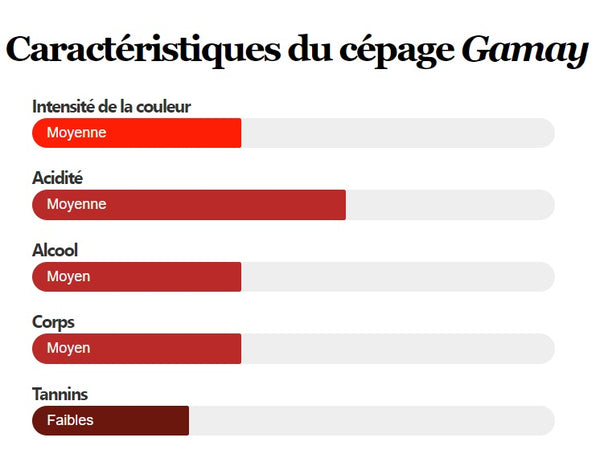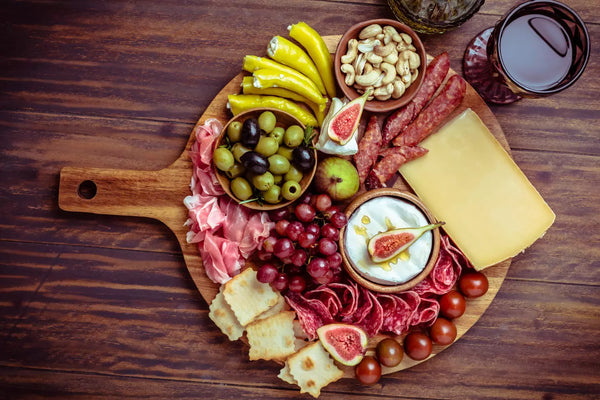Among the most emblematic grape varieties of France, the Gamay certainly stands out thanks to its centuries-old history as well as its delicious taste skills .
Sometimes criticized (very often through ignorance or shortcut), this variety nevertheless possesses many assets , which can offer the amateur of the pleasure wines as well as gastronomy , capable of being positioned as an aperitif as well as during a meal.
Thanks to this article, you will therefore discover the fantastic story of Gamay , his main aromatic markers or even how and with what to taste it in ideal conditions.
So, pour yourself a drink...and enjoy reading!
History of the Gamay
Gamay, or "black Gamay with white juice" (to distinguish it from its cousins) is the result of a crossing between the grape varieties Pinot noir and white Gouais . If the first is well known to enthusiasts and is still the pride of the Burgundy vineyard today, the second has nevertheless disappeared. It is also estimated that Gamay would be originally from the commune of Saint-Aubin, located in Côte de Beaune, within the Burgundy .
Although it is very likely that its history is older than that, o n finds the first written traces about him from the end of the 14th century .
It is indeed in 1395 that Philip the Bold promulgates an ordinance aimed at banish Gamay from its native land by these words: " This Gamay wine is of such a nature that it is very harmful to humans. […] several people who previously consumed it have been inconvenienced by serious illnesses. ; because this wine which comes from and is made with this plant, by its nature is full of a very great and unbearable bitterness […] because it gives off a strong and unpleasant odor »
If the chosen words seem very exaggerated today, it must be remembered that at the time, in the wine world, quantity was privileged over quality. As a result, and Gamay being by nature very fertile, the high yields then practiced did not allow us to get the best out of this delicious grape variety.
Thus, from the end of the 14th century, Gamay was uprooted and banned from a large part of Burgundy to be replanted further south, in the Mâconnais as well as in the Beaujolais , where it will acclimatize wonderfully to the climate as well as to the granite and clay-limestone soils .
During the following centuries, Gamay continued to develop throughout France, until it covered more than 160,000 hectares (10% of the national vineyard!). Unfortunately, the arrival of phylloxera , this famous parasite which ravaged European vineyards in the 19th century, will cause it to disappear from almost all wine-growing areas.

Places of culture of Gamay
Even today, it is still within Beaujolais that most of the Gamay vines are located. Thus, if we count 30,000 hectares of variety worldwide , more than 50% of it is planted in Beaujolais . In the region, Gamay even covers 99% of the vineyard!
Moreover, if other wine-growing areas also cultivate it, this is in a much less significant proportion. Thus, Burgundy (especially in the Mâconnais), uses it for example within its appellations Burgundy hillsides , Burgundy Passe-Tout-Grain or some Cremants .
Gamay is also found in the Loire to develop certain red wines , in Savoy , in Lorraine (AOC Côtes de Toul) or even in Auvergne (AOC Saint-Pourçain, Côte Roannaise etc.).
Abroad, it is well established in Swiss where it is the third most cultivated red grape variety, as well as anecdotally in many countries such as Italy, the United States, South Africa and Australia.
The characteristics of Gamay
THE Gamay is a grape variety primarily known for its production of red wines. slightly tannic, equipped with a nice freshness , and evolving on aromas of fresh red fruits (raspberry, strawberry, redcurrant, cherry, etc.). Most of the vintages produced in Beaujolais are also intended to be drunk while young (first 3 to 5 years).
In reality, this image of wines of friends represents part of the truth and it is important to qualify the whole. Gamay is indeed able to offer very different wines depending on the quality of the plant material, the age of the vines, the type of soil, the yields or even the winemaking method chosen by the winemaker. All these parameters actually have a determining influence on the quality of the wine you taste.
So, if you are looking for a red wine in AOC Beaujolais or Beaujolais-Villages vinified in carbonic maceration (a winemaking method typical of the region), you will then almost certainly have a fresh, colorful wine and flexible , expressing pronounced notes of tangy red fruits . THE Beaujolais New , the first wine of the year marketed every 3rd Thursday in November, is the archetype.
However, other Gamay wines exist. As well as this grape variety whether vinified in carbonic, semi-carbonic or traditional maceration, this one is also quite capable of offering concentrated, powerful wines and sometimes of long guard The aromatics of these Gamays will then tend more towards notes of ripe black fruits (black cherry, blackcurrant, prune), spices (pepper), and will also present a beautiful tannic structure.So be careful of shortcuts!
You will have understood, moreover, that in the middle of these two extremes, between light wine and powerful wine , Gamay also offers a myriad of possibilities of medium-age wines (5 to 8 years old), offering concentration and aromatic expression (red and black fruits, spices, violets, etc.) while maintaining freshness. Many appellation vintages such as Saint-Amour , Brouilly or even Flowery perfectly represent this balancing act.

Food and wine pairings and serving temperature
Given the different wine profiles that can be created from Gamay, there are many culinary possibilities available to you depending on the vintage you choose.
On a Gamay full of lightness and freshness, a platter of cold meats is for example a must. G thanks to its acidity and flexibility, o This type of wine can also be easily paired with cheeses like the County , THE Beaufort or even Brillat-Savarin . Finally, thanks to its low tannic concentration, it can also be combined with fish like Cod or Sea Bream.
With a Gamay of medium body with an interesting concentration, we will then move on to white meat agreements (roasted chicken with herbs, roast turkey, veal blanquette etc.).
Finally, with a powerful and tannic Gamay, the red meat will then become necessary to support the intensity of the wine. Lamb chops, beef entrecote, game etc.) will be excellent choices for example.
As for the proper serving temperature, this one will also vary depending on the profile of the wine. So, for a Fruity, concentrated and low-tannin Gamay, a relatively cool service between 14-16°C will be ideal. It could even go down to between 12-14°C for a Beaujolais Nouveau! On the other hand, with a powerful wine made from Gamay, a temperature between 16-18°C will be preferable in order to reveal its aromatic complexity and not tighten its tannins.

The best Gamays
To give a list of the best Gamays is a very subjective exercise because it depends above all on the type of wines you like! Nevertheless, whether you like fruity and light red wines, rather round and with a certain intensity or powerful and long-keeping, you will find what you are looking for in the selection of The Illuminated Cellar ! Here are some 100% Gamay nuggets just for you:
- Clos de la Roilette - Flowery - Late Vintage
- Cheveau Estate - Saint-Amour - Villa Violettes
- Coudert Estate - Brouilly
- Bodillard Vineyards - Beaujolais-Villages - 3B
- Bodillard Vineyards - Morgon - Marie-Louise
- Bodillard Vineyards - Morgon - Augustus X
So you will have understood, Gamay is a versatile grape variety offering delicious taste experiences. So don't limit it to Beaujolais Nouveau or simple light aperitif wines because, although such vintages from this grape variety are very pleasant, this variety is able to offer you a very diverse range of wines , thus adapting to almost any occasion. Health !












